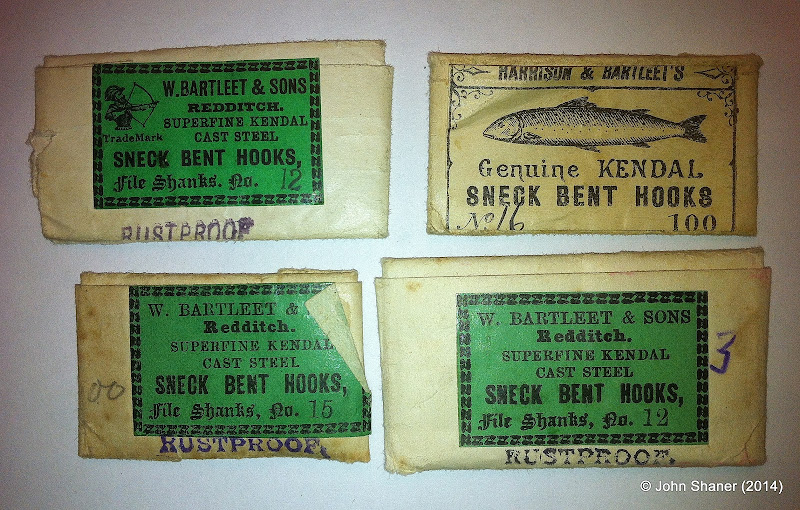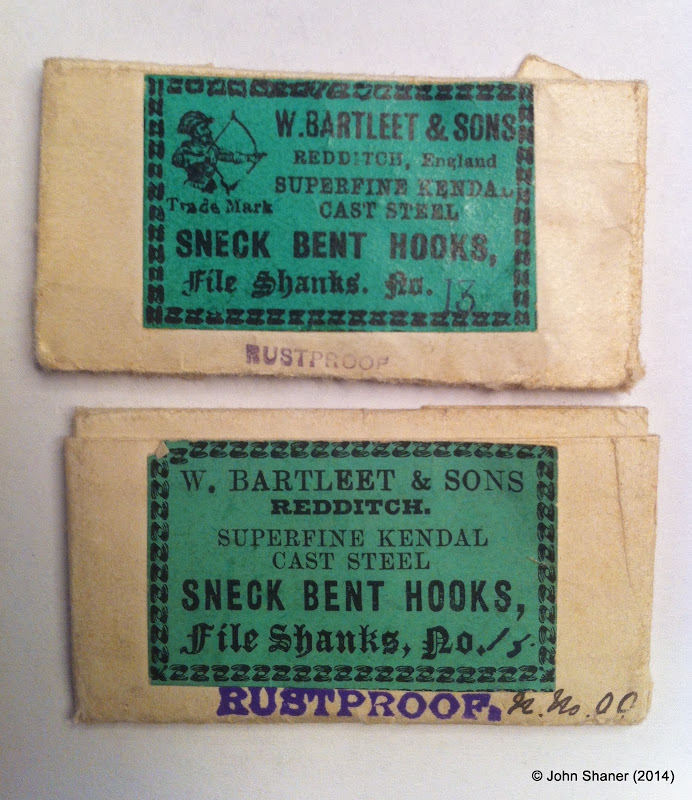I was recently contacted by Rob Smith, who is in the process of putting the finishing touches on his new book ("
The North Country Fly – Yorkshire Soft-hackled Tradition”, to be published in 2015). Rob provided additional information to supplement John's contributions so far.
HISTORICAL BACKGROUND INFORMATION FROM ROB SMITH:
"As my laptop screen is not calibrated it is hard say definitively what the chosen silk colour is. However, the photos posted look to be from Sylvester Lister manuscript of dressings. It is impossible to ascertain whether Henry Walbran Cooper or Sylvester Lister dressed these particular flies, though it has often been stated that Lister dressed a scruffy fly. Lister became partly paralysed in one arm due to a farming accident, and later taught himself to fish and fly-dress using the other arm. Both Cooper and Lister certainly knew each other as they were both connected with the Burnsall club, Lister as one of the founders and Cooper as a committee member of over 20 years.
The first of John’s photo’s appears to be:
1) Lister’s No. 2 Dark Bloa
Season - Feb to April
Hook - 0
Silk - Yellow
Body - Yellow silk dubbed with water-rats fur
Wings or Hackle - Under Waterhen wing, then Woodhawk's back as season progresses
Head - Magpie Herl
The Dark Bloa is a very old pattern and came be found in the Pickard manuscript of the late 1700s. Pre Swarbrick. The technique of trimming fly hackles is pretty universal in regards to the North Country patterns. It is a technique that is used by various fly-dressers and is merely a way of utilising large hackles when they have run out of suitable sized hackles. There is a way of dressing spiders with over long hackles without the need for trimming, but it is a technique that is almost impossible to master when tying flies in your hands without the aid of a vice. As John says, it is a matter of the tyer's aiming for size consistency.
There is no family connection between Max and Henry Walbran Cooper though they certainly knew each other and were both members of the same angling clubs.
The second photo appears again to be from Sylvester Lister’s manuscript. There is no wire reinforcing of the head, what you are seeing here is the refection from the herl stalk. A point to remember about most North Country dressings, is that they were often in a sense dressed backwards. So on these patterns the herl head is dressed in first, then the hackle and then finished with the body. This prescribed method is easier to do in the hand that the todays method of working to the front.
2) No.17 Dark Snipe (Snipe & Purple)
Season - April 1st
Hook – 00
Silk – Purple
Body – Purple
Wings or Hackle - Speckled feather from outside of a Snipe's wing
Head - Peacock Herl
Photo three again appears to be from Sylvester Lister. The clue seems to be in the hackle which is quite a noticeable light blueish grey, which rules out Coot, Waterhen and Jackdaw.
3) No.21 Dark Watchett (Iron Blue Dun)
Season - Cold Days
Hook – 00
Silk - Orange and purple
Body - Orange and purple silk twisted with a little mole's fur
Wings or Hackle - Feather from back of Merlin hawk
Head - Orange Silk
The Dark Watchet is of course an ancient pattern and can be seen with numerous watchet patterns in Yorkshire manuscripts dating as far back as the 1600s. Including one called the Bloa Watchet!
In regards to John’s photos; the first fly appears to be Whitaker’s dressing of the Little Brown
Little Brown (James Whitaker C-1880)
Hook – 0
Silk – Orange or Yellow
Body – Orange silk or yellow dubbed with fox fur or hare poll
Legs – Wren tail
Head – Peacock harl
This pattern is found in several North Country lists but so far I have only been able to find this dressing with a dubbed body. James Whitaker was known to both Walbran Cooper and Sylvester Lister. Whitaker was Lister’s overseer at Bolton Abbey and river-keeper on the Bolton Abbey Estate. Whitaker and his brother were also founders of the Burnsall Club Angling Club along with Sylvester Lister. Whitaker’s list is found in a few Max Walbran catalogues, he was also a fishing guide and fly-dresser. Wrens tail looks like a cross between partridge back and snipe rump. Wren hackle barbs are longer and thinner than partridge and the barb count slightly higher, so it is generally dressed quite sparse even by North Country standards. It will have chestnut reddish tints, depending on how faded the hackle is.
Whitaker’s son Willie is the “local professional” in Edmonds & Lee’s Brook & River Trouting
There is also the possibility that this is a version of the Brown Watchet. Though this pattern appears to never have been dubbed. Though Turton uses wren tail in his dressing of the Brown Watchet.
Regards
Rob"
THANKS ROB.
And here is the next fly from John's collection:

I can tell you that my jaw dropped open (

) when I saw the herl body on this fly. Can you believe how perfect this fly is? Absolutely incredible!
John - Did you steam this fly, to restore the herl fibers? This fly looks like it was just tied, five minutes ago.




